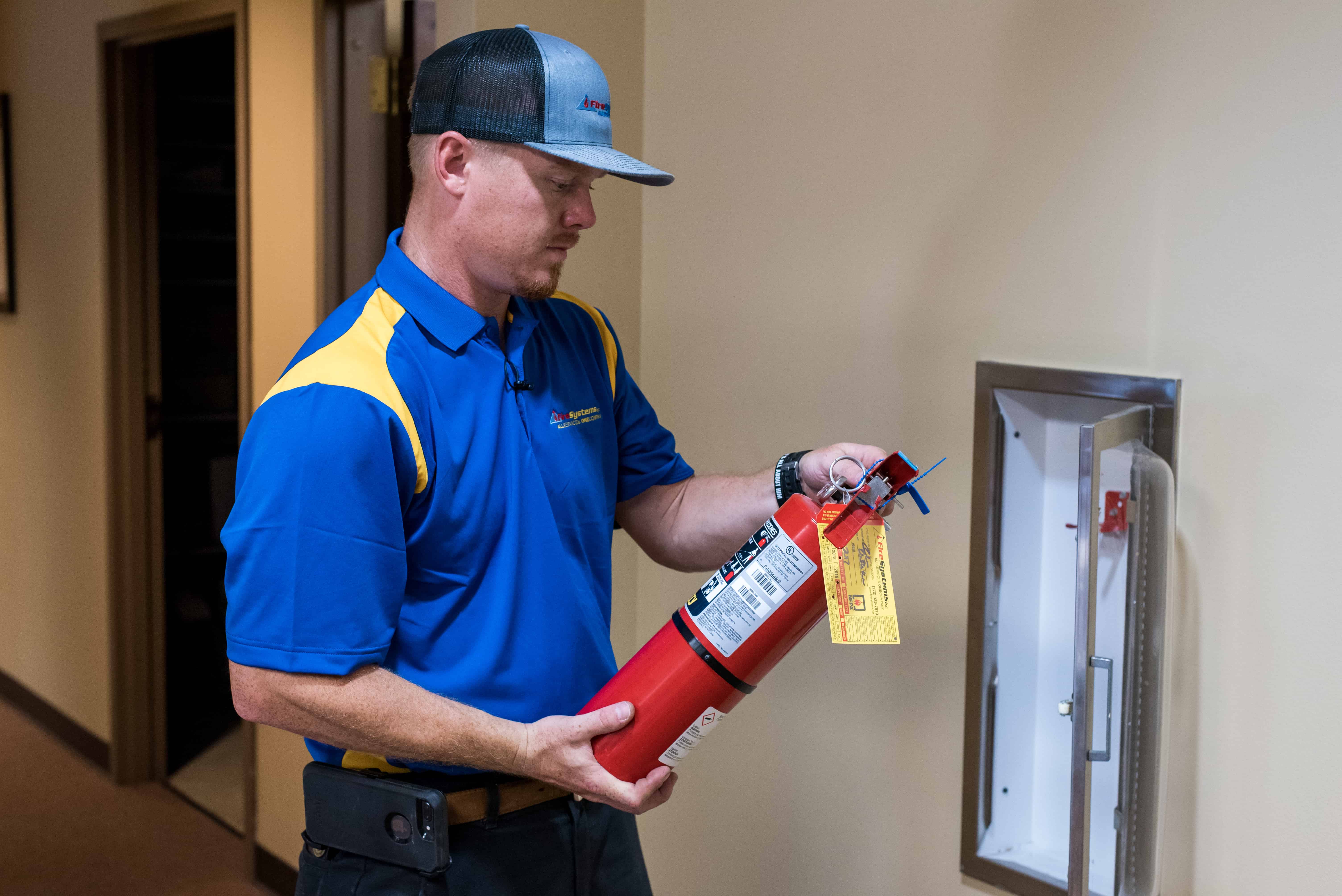The portable fire extinguishers that protect your building require annual maintenance inspections by a licensed fire protection professional. They also require monthly visual inspections by the building owner.
Fire extinguisher inspections are important as they ensure properly functionality of your extinguishers. Inspections are also a requirement for fire code compliancy. Neglecting to maintain annual fire extinguisher inspections can lead to citations from your local fire department.
NFPA 10 is the standard for portable fire extinguishers. The code addresses the importance that certain conditions are met to ensure proper functionality of your building’s portable fire extinguishers (i.e. proper location of the extinguisher, correct type, etc.). NFPA 10 also outlines the steps required to conduct fire extinguisher inspections.
Here is what you can expect if you have your annual fire extinguisher inspection coming up.
Preparing for your annual inspection
The fire extinguisher technician scheduled to conduct your inspection will review the extinguisher report from the previous year prior to your annual inspection.
The purpose of reviewing this report is to determine if any of your fire extinguishers will be due for six-year maintenance or 12-year hydrostatic testing. This information helps the tech come prepared and save extra unnecessary trips if they already have the extinguishers they need already on their truck.
Upon arrival
The first thing the tech will do upon arrival is reach out to their assigned point of contact. The tech will let this person know they are on-site and there to perform the annual fire extinguisher inspections.
It’s at this time that the tech asks the customer if they’d like to have someone walk with them through the inspection process. Some customers prefer to allow building access to conduct the inspection alone while others would like an individual to walk with the tech.
The tech communicates to the customer how many extinguishers will possibly be due for maintenance on this visit. The customer has the opportunity to either let the tech take care of the extinguishers as needed or provide a quote at the end of the inspection.
Visual inspection of exterior
 Annual fire extinguisher inspections begin with a visual examination of the exterior. The tech thoroughly examines each cylinder for dents, damage, repairs, or corrosion. They look at the pressure gauge, hose or nozzle threads, handles, and levers.
Annual fire extinguisher inspections begin with a visual examination of the exterior. The tech thoroughly examines each cylinder for dents, damage, repairs, or corrosion. They look at the pressure gauge, hose or nozzle threads, handles, and levers.
A visual inspection of the extinguishers verifies that the hanger, bracket, or cabinet is the proper one for the extinguisher, and that it’s secure, undamaged, and properly mounted.
After ensuring the extinguisher and mounting is free from damage, the tech checks the nameplate operating instructions. The instructions should be legible and facing outward. It’s at this time the tech confirms the extinguisher model isn’t subject to recall or obsolete.
Other visual checks completed by the tech at this time include:
- Confirm that the pull pin functions properly and examine for damage or corrosion by pulling the pull pin.
- Check that the handle and levers are undamaged and operable.
- Verify that the pressure gauge or indicator is in the operable range and undamaged.
- Check that the gauge operating pressure corresponds with the nameplate instructions.
- Make sure that the gauge face corresponds with the proper agent type.
Functional testing
It’s time for the functional testing portion of the inspection after conducting a visual examination.
The tech removes and examines the nozzle to check if the nozzle/hose assembly is unobstructed. He confirms the nozzle and hose assembly are correct for the model of extinguisher and verifies that the hose and couplings are not cut, cracked, damaged, or deformed.
Next is an examination of the internal valve port surfaces and threads. Here, the tech looks for signs of leakage or corrosion by removing nozzle/hose assembly and reinstalling the nozzle and hose assembly. The tech verifies that the hose retention band is secure and properly adjusted.
Now the extinguishers are weighed to verify that the extinguishers correspond to the weight listed on the nameplate. After weighing, the tech reinstalls the ring pin and installs a new tamper seal. The tech then cleans the exposed extinguisher surfaces to remove any foreign material.
Finally, the tech records the maintenance on the extinguisher tag or label and returns the extinguisher to the hanger, bracket, or cabinet.
Review inspection findings
Once the inspections are complete, the tech makes any necessary changes to the report from last year to ensure correct dates on any work that was performed. It’s also at this time that the tech reviews the inspection with the customer and inform them of any damage or necessary repairs.
It’s the job of the tech to ensure there are sufficient fire extinguishers for the hazard area. If that’s not the case, the tech informs the customer that additional extinguishers need to be added to that area.
The tech then fills out his service ticket and has the customer sign it. The tech will leave a copy for the customer’s records. The updated extinguisher report will be emailed to the customer once it is completed at the office.
Choosing a fire protection company
Fire Systems, Inc. has decades of experience servicing all types of fire suppression systems, including CO2, Halon, and FM-200. We are experienced and mindful of the certifications, permits, and requirements demanded by local building, fire departments, and insurance providers. Our technicians are fully trained and certified to ensure that your systems are fully functioning.
We can also provide training in the proper use and maintenance of your system. Inspections are performed using Fire Systems technicians—with no sub-contracting.
Call Fire Systems today at 770-333-7979 or visit our website to schedule your annual fire extinguisher inspections today!






